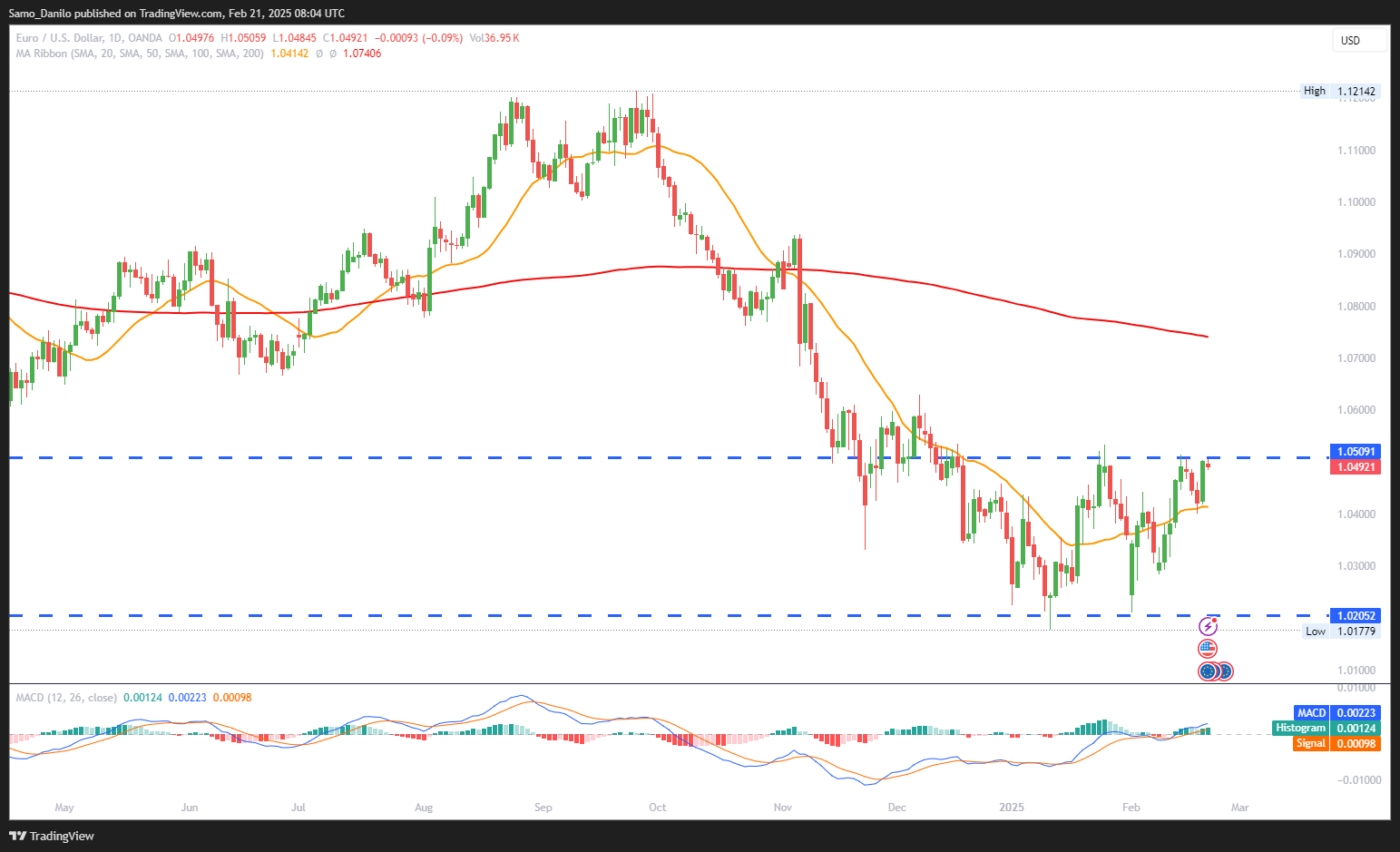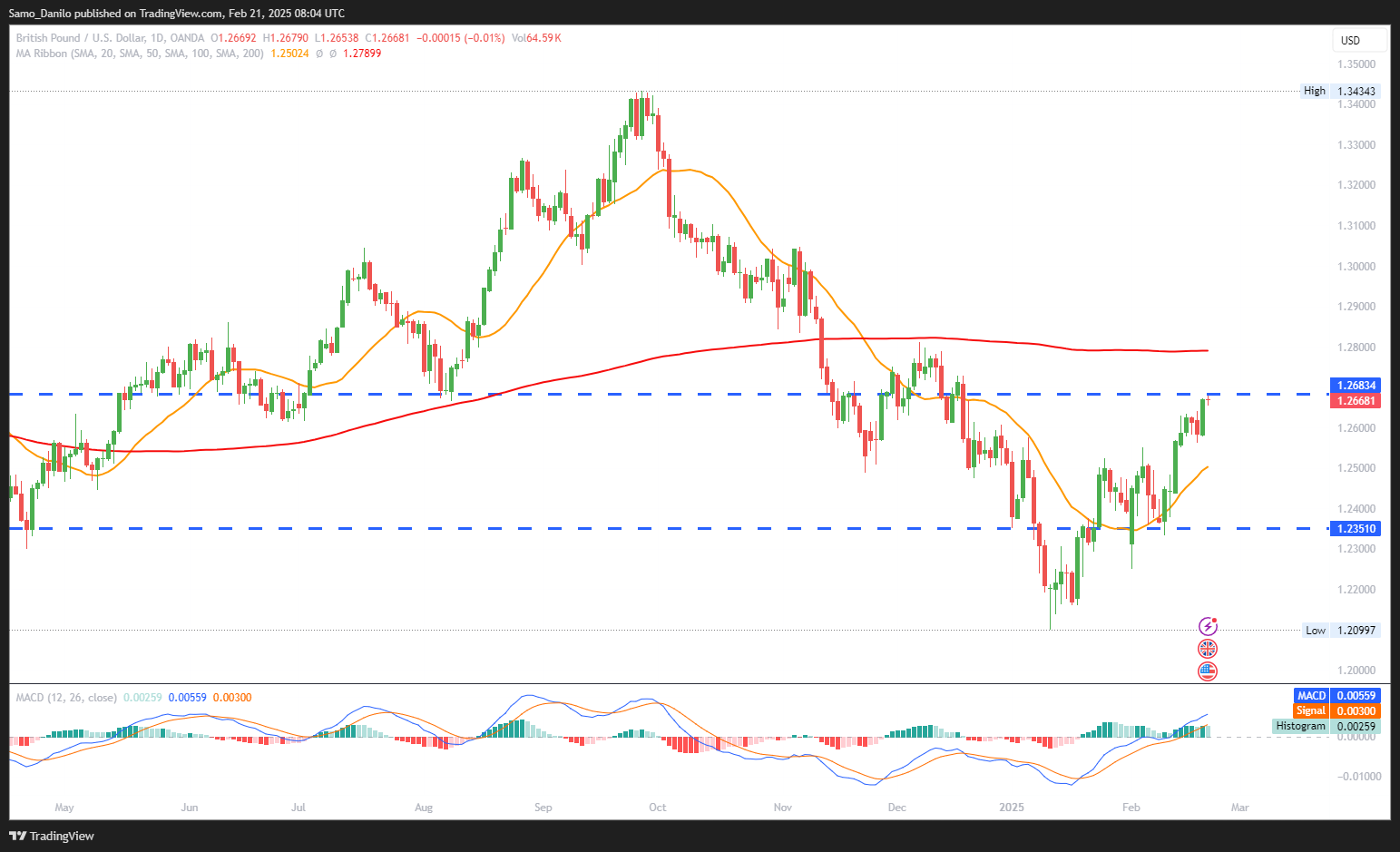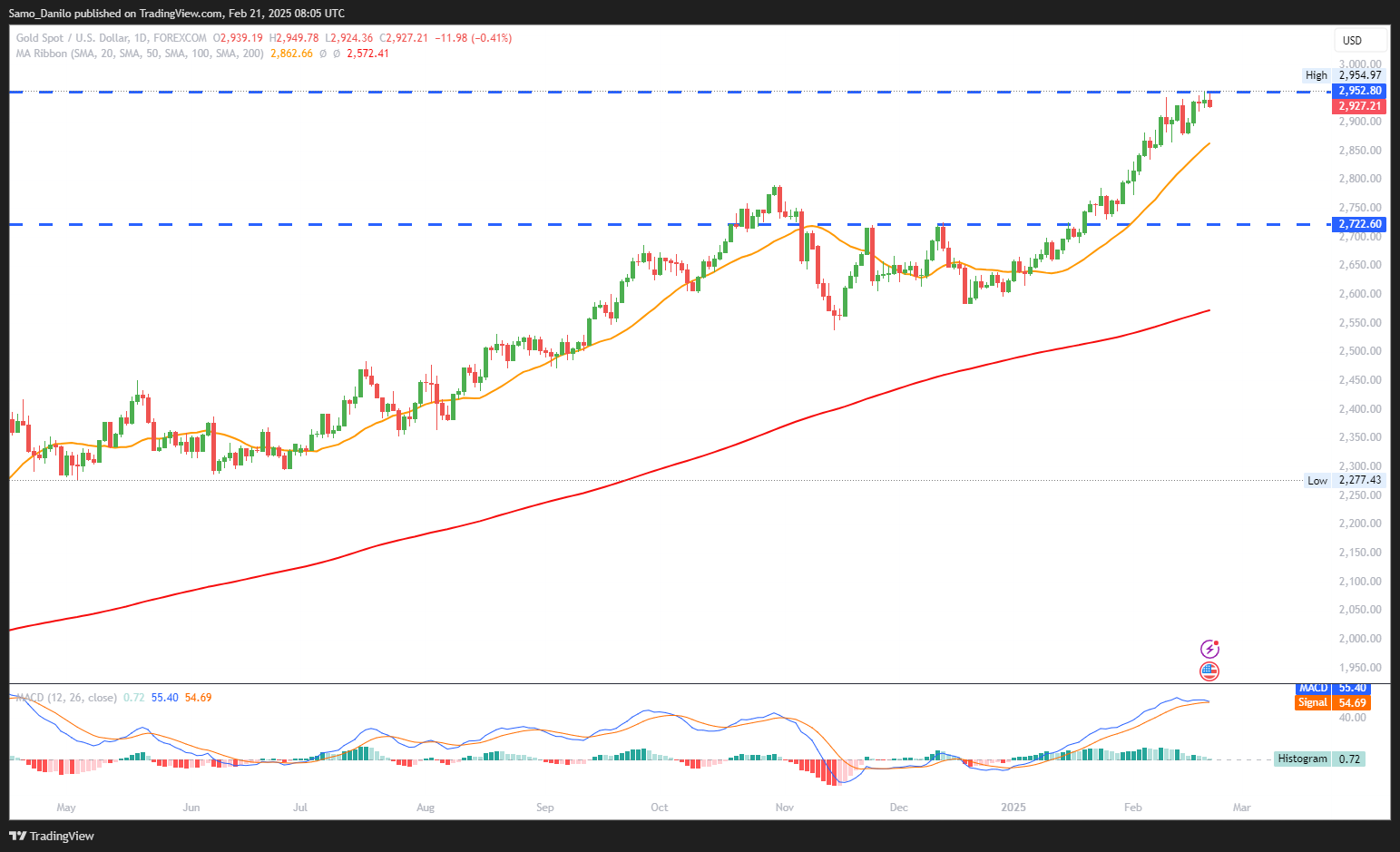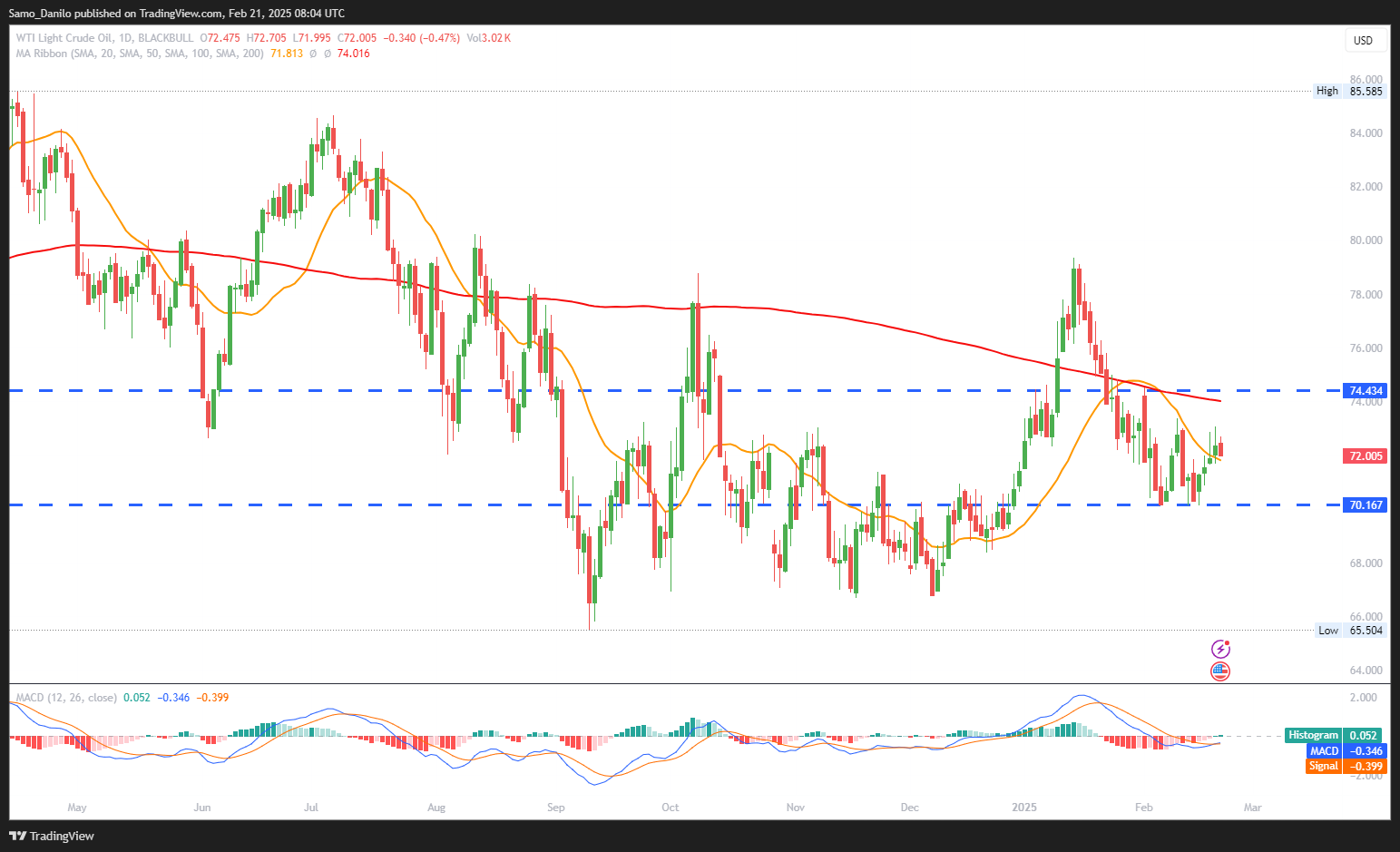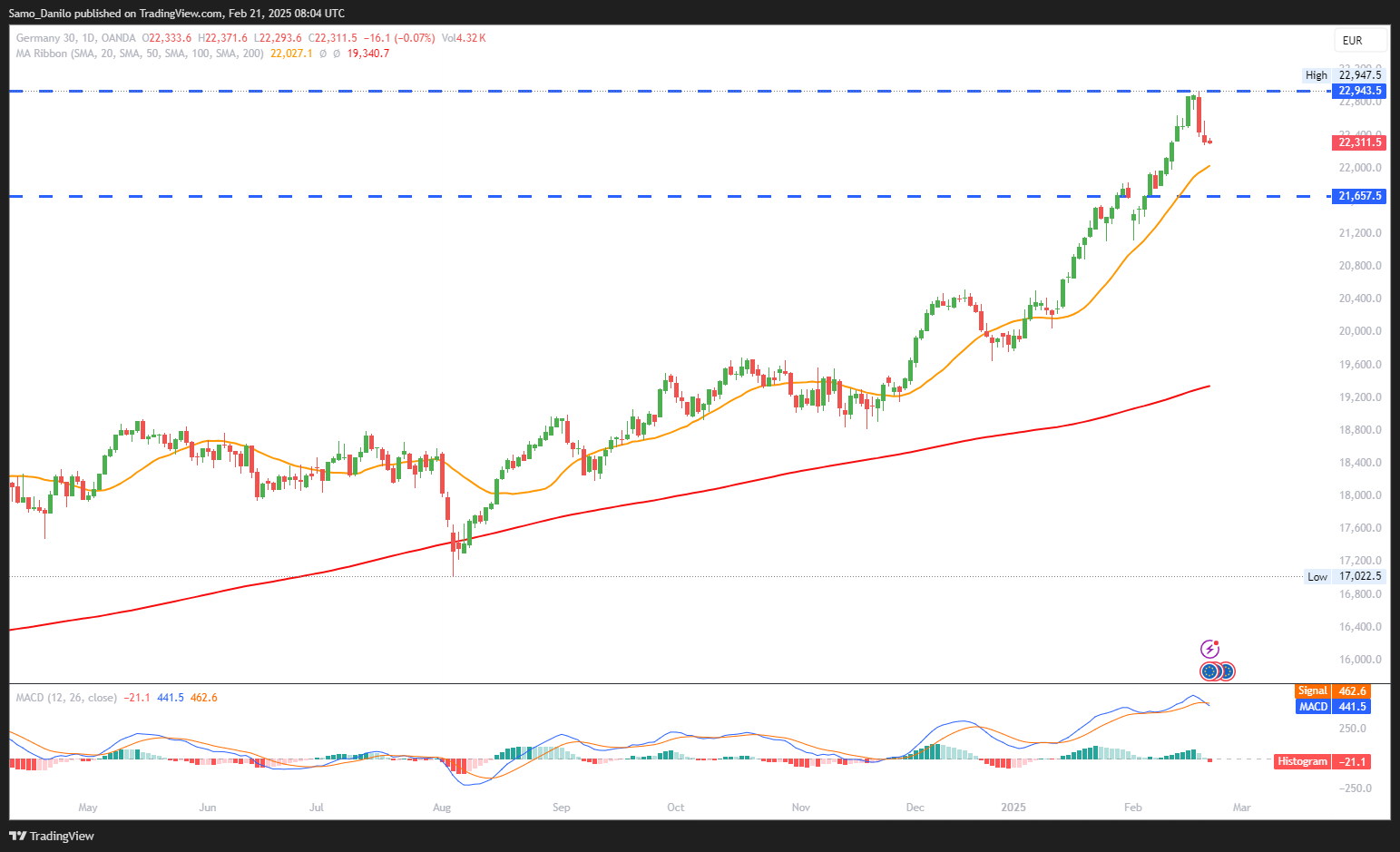EURUSD
- EUR/USD Price: The EUR/USD pair trades near 1.0500 during the European session on Friday, retreating after booking solid gains in the previous session. The pullback suggests traders are locking in profits ahead of key economic data releases.
- Technical Setup: A closer look at the daily chart reveals a potential bearish reversal, as EUR/USD is trading within a rising wedge pattern. This formation, combined with declining trading volume, signals weakening buying pressure and raises the risk of a downside move.
- ECB's Schnabel: ECB Executive Board member Isabel Schnabel hinted at a possible "halt" in the central bank’s monetary expansion cycle. She warned that inflation risks remain tilted to the upside, even as borrowing costs have eased significantly.
- ECB Rate Cuts: Analysts anticipate that the ECB will implement 25-basis-point rate cuts at every policy meeting until mid-2025, potentially bringing the deposit rate down to 2.0%. However, persistently high inflation could challenge these expectations.
- Economic Data: Traders will closely watch the preliminary HCOB Purchasing Managers’ Index (PMI) figures for the Eurozone and Germany, set for release on Friday. These data points could influence ECB policy bets and impact the euro’s short-term trajectory.
Closing statement: EUR/USD faces potential downside pressure amid technical weakness and cautious ECB messaging. Traders will look to PMI data for fresh direction, while expectations of gradual ECB rate cuts remain a key driver for the euro’s outlook.
GBPUSD
- GBP/USD Price: The Pound Sterling extends its bullish momentum, with GBP/USD trading above 1.2670 during the European session on Friday. Upbeat UK economic data continues to support the pair’s advance.
- UK Retail Sales: UK Retail Sales surged 1.7% MoM in January, recovering from December’s 0.6% decline. The data, released by the Office for National Statistics (ONS), signals improving consumer sentiment and economic resilience, bolstering the Pound.
- Geopolitical and Trade Developments: Hopes of a Russia-Ukraine peace deal and the postponement of Trump’s reciprocal tariffs have sustained risk appetite, keeping GBP/USD supported throughout the week.
- US Inflation Data: While both the US Consumer Price Index (CPI) and Producer Price Index (PPI) came in hotter than expected for January, the monthly components of PPI softened. This has reinforced dovish expectations that the Federal Reserve (Fed) may still cut rates later in 2025.
- US Jobless Claims: Initial jobless claims in the US increased to 219K for the week ending February 15, according to the Department of Labor. The uptick in unemployment claims adds to signs of labor market cooling, which could weigh on the US Dollar further.
Closing statement: GBP/USD remains well-supported, benefiting from strong UK economic data and favorable risk sentiment. While US inflation data initially fueled hawkish Fed bets, softer PPI details and rising jobless claims have kept rate cut expectations intact. The pair could extend gains if bullish momentum persists.
XAUUSD
- XAU/USD Price: Gold price retreats from near its all-time high as traders engage in profit-taking. However, downside risks appear limited, with the 14-day Relative Strength Index (RSI) at 69.25, indicating continued bullish sentiment.
- Profit-Taking: The latest pullback is largely driven by traders repositioning ahead of the S&P Global Preliminary Business PMIs, the first major US economic release of the week, which could influence short-term gold price movements.
- Fed Minutes: The January FOMC minutes revealed that “many participants” favor holding interest rates at restrictive levels if economic strength and inflation persist, particularly amid uncertainty over Trump’s trade policies. This reinforces the Fed’s wait-and-see approach, keeping gold resilient.
- Geopolitical Tensions: Ongoing tariff discussions by Trump and renewed geopolitical tensions surrounding a potential Russia-Ukraine peace deal continue to provide a safe-haven bid for gold, supporting its rally.
- FED's Musalem: St. Louis Fed President Alberto Musalem warned on Thursday about the risk of rising inflation expectations coupled with potential stagflation, creating a complex economic backdrop that favors gold as an inflation hedge.
Closing statement: Gold remains in a strong uptrend, with only brief dips driven by profit-taking and event risk. Persistent geopolitical concerns, cautious Fed rhetoric, and stagflation risks continue to underpin demand. The upcoming US economic data releases will be key in determining the next directional move.
CRUDE OIL
- WTI Oil Price: West Texas Intermediate (WTI) crude oil prices trade within a narrow range during Friday’s European session, consolidating the gains recorded over the past four days as investors assess the market outlook.
- US Inventory Data: The latest Energy Information Administration (EIA) report showed an increase in US crude oil stockpiles, while gasoline and distillate inventories declined. This mixed data reflects shifting supply-demand dynamics, adding uncertainty to oil price movements.
- Russia-Ukraine Developments: Optimism over a potential Russia-Ukraine peace deal has diminished as Ukrainian drone strikes on Russian oil infrastructure escalate. Geopolitical risks continue to influence oil market sentiment, limiting downside potential.
- Slowing Demand: Signs of weakening demand from major economies like the Eurozone and China introduce caution into the market. Investors remain wary of the global economic slowdown’s impact on oil consumption, which could cap further price recovery.
- Fed’s Kugler: Fed Board Governor Adriana Kugler emphasized that inflation remains above the 2% target and warned of a bumpy path ahead. Persistent inflationary pressures could influence monetary policy expectations, indirectly impacting crude oil demand.
Closing statement: WTI crude oil remains in a consolidation phase as traders balance supply concerns, geopolitical risks, and global demand uncertainty. The direction of oil prices will depend on further geopolitical developments and macroeconomic data releases.
DAX
- DAX Price: The DAX dropped 0.53% on Thursday, extending Wednesday’s 1.80% plunge to close at 22,315. Investor sentiment remains fragile as concerns over corporate earnings, US tariff uncertainties, and Germany’s upcoming election weigh on the index.
- Producer Prices: Germany’s Producer Price Index (PPI) rose 0.5% YoY in January, easing from December’s 0.8% increase. As a leading inflation indicator, softer producer prices could translate into lower consumer inflation, potentially influencing European Central Bank (ECB) policy expectations.
- Germany’s PMI Data: Investors are eyeing Germany’s private sector Purchasing Managers’ Index (PMI) data on Friday. Forecasts suggest a slight rise in the HCOB Manufacturing PMI to 45.5 from 45.0, while the Services PMI is expected to remain stable at 52.5, reflecting moderate expansion in the services sector.
- Germany’s Election: The February 23 German elections carry significant economic implications. With GDP stagnating for three years and manufacturing production capacity shrinking for the first time since reunification, investors remain cautious about potential policy shifts.
- US Services PMI: The US S&P Global Services PMI, scheduled for release on Friday, is expected to edge up to 53.0 from 52.9 in January. A stronger-than-expected reading could impact global risk sentiment and influence DAX movements.
Closing statement: The DAX faces downside risks amid election uncertainty, global economic concerns, and shifting inflation trends. Market participants will closely watch German PMI data and US economic indicators for further direction.
